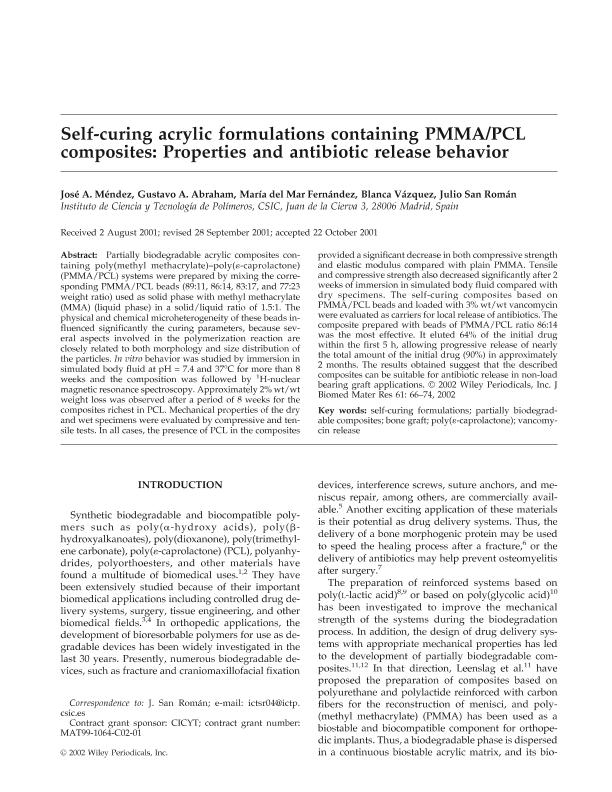Mostrar el registro sencillo del ítem
dc.contributor.author
Méndez, José A.
dc.contributor.author
Abraham, Gustavo Abel

dc.contributor.author
Fernández, María Del Mar
dc.contributor.author
Vázquez, Blanca
dc.contributor.author
Román, Julio San
dc.date.available
2018-08-13T16:57:26Z
dc.date.issued
2002-12
dc.identifier.citation
Méndez, José A.; Abraham, Gustavo Abel; Fernández, María Del Mar; Vázquez, Blanca; Román, Julio San; Self-curing acrylic formulations containing PMMA/PCL composites: Properties and antibiotic release behavior; Wiley; Journal Of Biomedical Materials Research; 61; 1; 12-2002; 66-74
dc.identifier.issn
0021-9304
dc.identifier.uri
http://hdl.handle.net/11336/55130
dc.description.abstract
Partially biodegradable acrylic composites containing poly(methyl methacrylate)-poly(ε-caprolactone) (PMMA/PCL) systems were prepared by mixing the corresponding PMMA/PCL beads (89:11, 86:14, 83:17, and 77:23 weight ratio) used as solid phase with methyl methacrylate (MMA) (liquid phase) in a solid/liquid ratio of 1.5:1. The physical and chemical microheterogeneity of these beads influenced significantly the curing parameters, because several aspects involved in the polymerization reaction are closely related to both morphology and size distribution of the particles. In vitro behavior was studied by immersion in simulated body fluid at pH = 7.4 and 37°C for more than 8 weeks and the composition was followed by 1H-nuclear magnetic resonance spectroscopy. Approximately 2% wt/wt weight loss was observed after a period of 8 weeks for the composites richest in PCL. Mechanical properties of the dry and wet specimens were evaluated by compressive and tensile tests. In all cases, the presence of PCL in the composites provided a significant decrease in both compressive strength and elastic modulus compared with plain PMMA. Tensile and compressive strength also decreased significantly after 2 weeks of immersion in simulated body fluid compared with dry specimens. The self-curing composites based on PMMA/PCL beads and loaded with 3% wt/wt vancomycin were evaluated as carriers for local release of antibiotics. The composite prepared with beads of PMMA/PCL ratio 86:14 was the most effective. It eluted 64% of the initial drug within the first 5 h, allowing progressive release of nearly the total amount of the initial drug (90%) in approximately 2 months. The results obtained suggest that the described composites can be suitable for antibiotic release in non-load bearing graft applications. © 2002 Wiley Periodicals, Inc.
dc.format
application/pdf
dc.language.iso
eng
dc.publisher
Wiley

dc.rights
info:eu-repo/semantics/openAccess
dc.rights.uri
https://creativecommons.org/licenses/by-nc-sa/2.5/ar/
dc.subject
Bone Graft
dc.subject
Partially Biodegradable Composites
dc.subject
Poly(Ε-Caprolactone)
dc.subject
Self-Curing Formulations
dc.subject
Vancomycin Release
dc.subject.classification
Inmunología

dc.subject.classification
Medicina Básica

dc.subject.classification
CIENCIAS MÉDICAS Y DE LA SALUD

dc.title
Self-curing acrylic formulations containing PMMA/PCL composites: Properties and antibiotic release behavior
dc.type
info:eu-repo/semantics/article
dc.type
info:ar-repo/semantics/artículo
dc.type
info:eu-repo/semantics/publishedVersion
dc.date.updated
2018-07-11T17:27:01Z
dc.journal.volume
61
dc.journal.number
1
dc.journal.pagination
66-74
dc.journal.pais
Estados Unidos

dc.journal.ciudad
Hoboken
dc.description.fil
Fil: Méndez, José A.. Consejo Superior de Investigaciones Científicas; España. Instituto en Ciencia y Tecnología de Polímeros; España
dc.description.fil
Fil: Abraham, Gustavo Abel. Consejo Nacional de Investigaciones Científicas y Técnicas; Argentina. Consejo Superior de Investigaciones Científicas; España. Instituto en Ciencia y Tecnología de Polímeros; España
dc.description.fil
Fil: Fernández, María Del Mar. Consejo Superior de Investigaciones Científicas; España. Instituto en Ciencia y Tecnología de Polímeros; España
dc.description.fil
Fil: Vázquez, Blanca. Consejo Superior de Investigaciones Científicas; España. Instituto en Ciencia y Tecnología de Polímeros; España
dc.description.fil
Fil: Román, Julio San. Consejo Superior de Investigaciones Científicas; España. Instituto en Ciencia y Tecnología de Polímeros; España
dc.journal.title
Journal Of Biomedical Materials Research

dc.relation.alternativeid
info:eu-repo/semantics/altIdentifier/doi/https://dx.doi.org/10.1002/jbm.10142
dc.relation.alternativeid
info:eu-repo/semantics/altIdentifier/url/https://onlinelibrary.wiley.com/doi/abs/10.1002/jbm.10142
Archivos asociados
